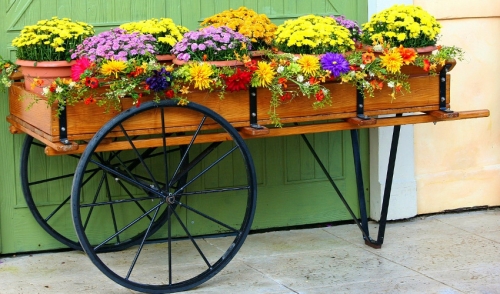Chrysanthemums are well known as a popular fall flower with their jewel-like colors in rich autumn hues, but did you know these flowers can be equally beautiful and versatile in a spring garden or landscape? Don't keep mum about spring mums, and get these blooms established in your yard early for long-lasting beauty.
About Chrysanthemums
Chrysanthemums are perennial flowers originally found from northeastern Europe to Asia. They were cultivated in China as early as 1400 BC, and today there are thousands of mum cultivars all over the world. The colors of mums range from rich reds, golds and bronzes to lighter yellow, white, ivory, orange, pink and purple shades. The shape of different cultivars also varies widely, and the blooms may be daisy-like, fluffy cushions, compact buttons or gangly quills or spiders.
While in northern areas more delicate varieties are typically annuals, many regions can enjoy perennial mums with stunning growth and blooms from year to year if they're cared for appropriately.
Mums in Spring
Traditionally, many garden centers have only carried chrysanthemums as full, forced containers available in full bloom each autumn. While these are good quality plants and can be amazing decorative accents to your yard, planting mums in fall does not give the plants sufficient time before the first frost to establish a healthy root system to sustain them through the bitter winter, and these flowers are often treated as annuals. More and more often now, however, higher quality nurseries with more diverse selections are offering mums in the spring, and they can also be ordered through reputable catalogs or specialty organizations like the National Chrysanthemum Society.
When planting mums in spring, it is important to take their needs into account, not just position them for the best fall view. These flowers prefer slightly acidic soil that is very well drained, typically with a sandy or loamy texture. For the brightest, fullest, most colorful blooms, it is critical that mums get enough sunlight – at least 3-5 hours of sun per day, and full sun locations are best. Morning sun is especially preferred, as it will help dry off morning dew and minimize mold or fungus that can affect mums. It is important, however, not to plant mums near artificial night lighting sources, such as pathway lights or streetlights, as too much light at night can disrupt their natural flowering.
Mums should be spaced appropriately to accommodate their mature size – whether they are regular or dwarf cultivars – so they have proper air circulation. This will also help keep moisture off the foliage and minimize the risk of any fungus problems.
Adding some well-seasoned compost to the planting hole will help nourish mums as they get established, and regular, light feedings of a good fertilizer will ensure plentiful summer growth to support brilliant fall blooms. Mums must be watered regularly while growing through the summer, beginning with one inch of water per week and increasing watering when needed through hot temperatures or drought conditions.
During their summer growth, gently pinching off longer stems of chrysanthemums will help keep the plants to their compact, mounding, bushy shape, ensuring a brilliant floral show when their blooms burst forth. Avoid pinching off in late summer, however, as there will not be enough time for new buds to set and late pinching will lead to gaps in the flower coverage.
With proper care of the mums you've planted in spring, you can enjoy their mounding foliage throughout the summer and be stunned as their fall show bursts forth in astonishing colors. Since the plants have had the opportunity to become properly established, they'll return year after year to continue adding color and brilliance to your landscape. Why wait? Nurture and enjoy your mums in spring just as much as you do in fall!






Comments